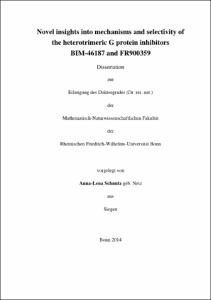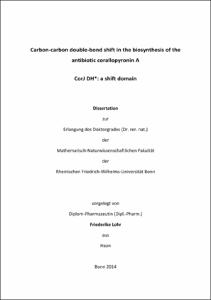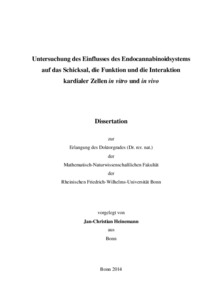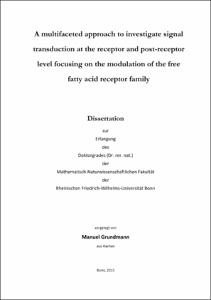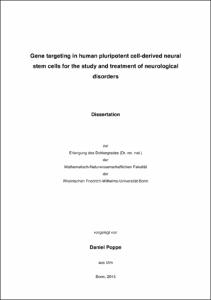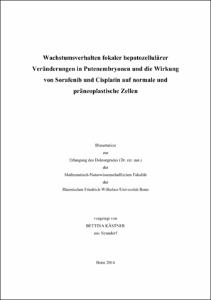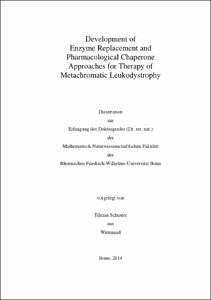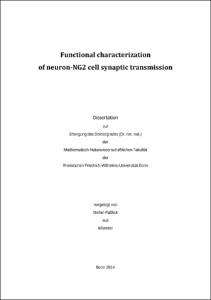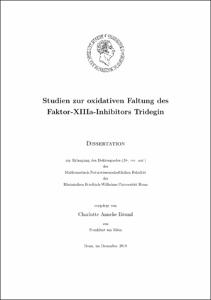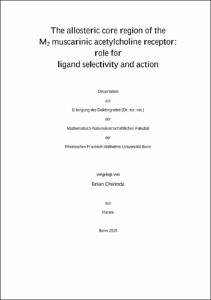E-Dissertationen: Suche
Anzeige der Dokumente 1-10 von 34
Novel insights into mechanisms and selectivity of the heterotrimeric G protein inhibitors BIM-46187 and FR900359
(2015-04-24)
Selective silencing of Gα protein subfamilies by small molecules is of great value to explore the contribution of G protein signaling in physiology and disease. It also represents a new opportunity to treat diseases, such ...
Carbon-carbon double-bond shift in the biosynthesis of the antibiotic corallopyronin A: CorJ DH*: a shift domain
(2015-03-13)
Corallopyronin A is a myxobacterial compound, which was isolated in our lab from the strain Corallococcus coralloides B035. It is a potent in vivo active antibiotic, which is currently undergoing preclinical studies. ...
Untersuchung des Einflusses des Endocannabinoidsystems auf das Schicksal, die Funktion und die Interaktion kardialer Zellen in vitro und in vivo
(2015-01-19)
Diverse Arbeiten demonstrieren den Einfluss des Endocannabinoidsystems (ECS) auf regulatorische Mechanismen im ischämischen Myokard. Besonders der Cannabinoidrezeptor 2 (CB2R) scheint an diesen Prozessen zu partizipieren ......
A multifaceted approach to investigate signal transduction at the receptor and post-receptor level focusing on the modulation of the free fatty acid receptor family
(2015-11-16)
Knowledge about the function and dysfunction of cellular signal transduction is at the very heart of biomedical research since every physiological and pathophysiological process is intimately associated with adequate or ...
Gene targeting in human pluripotent cell-derived neural stem cells for the study and treatment of neurological disorders
(2015-11-19)
Modern stem cell technology has made remarkable progress in recent years with the discovery of induced pluripotency, enabling the production of any cell type from any person in unlimited quantities, as well as improved ...
Wachstumsverhalten fokaler hepatozellulärer Veränderungen in Putenembryonen und die Wirkung von Sorafenib und Cisplatin auf normale und präneoplastische Zellen
(2014-11-28)
In der vorliegenden Arbeit wurde die Möglichkeit der embryonalen Putenleber als Modell zum Test potenzieller Tumortherapeutika untersucht. Es konnten verlässlich fokale hepatozelluläre Veränderungen (foci of altered ...
Development of Enzyme Replacement and Pharmacological Chaperone Approaches for Therapy of Metachromatic Leukodystrophy
(2015-01-06)
Metachromatic leukodystrophy (MLD) is a monogenic, autosomally recessively inherited lysosomal storage disease. Certain mutations of the arylsulfatase A (ASA) gene cause misfolding or absence of ASA. Physiologically ASA ...
Functional characterization of neuron-NG2 cell synaptic transmission
(2014-09-11)
NG2 cells are nowadays considered as a fourth class of glial cells in the CNS. They express various types of voltage-gated ion channels and neurotransmitter receptors and exhibit the capability to proliferate and differentiate. ...
Studien zur oxidativen Faltung des Faktor-XIIIa-Inhibitors Tridegin
(2020-11-16)
Diese Dissertation beschäftigt sich mit der umfassenden Charakterisierung des Naturstoffs Tridegin. Dieses cysteinreiche, 66 Aminosäuren lange Peptid ist ein spezifischer Inhibitor des letzten Schrittes der Blutgerinnungskaskade, ......
Studies on the oxidative folding of factor XIIIa inhibitor tridegin
This PhD thesis deals with the detailed characterization of the natural compound tridegin. This cysteine-rich 66mer peptide ......
Studies on the oxidative folding of factor XIIIa inhibitor tridegin
This PhD thesis deals with the detailed characterization of the natural compound tridegin. This cysteine-rich 66mer peptide ......
The allosteric core region of the M2 muscarinic acetylcholine receptor: role for ligand selectivity and action
(2015-09-23)
Muscarinic acetylcholine receptors (mAChRs) are seven transmembrane domain-spanning proteins belonging to the family A of G protein-coupled receptors (GPCRs). In addition to the orthosteric binding site (i.e. the site where ...


